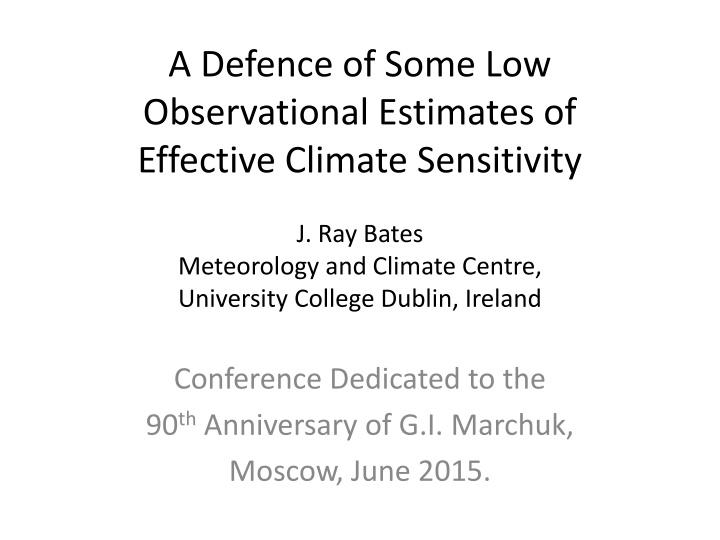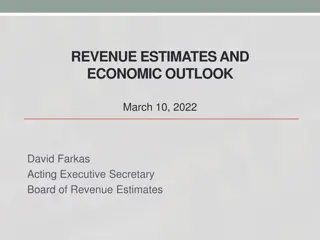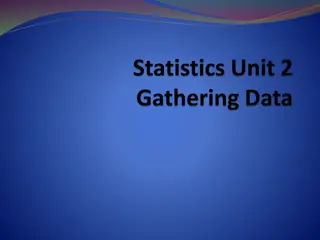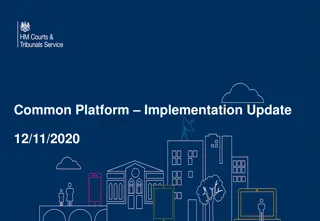A Defence of Some Low Observational Estimates of Effective Climate Sensitivity
This content discusses low observational estimates of Effective Climate Sensitivity, including the definitions of Equilibrium Climate Sensitivity and Effective Climate Sensitivity by the IPCC, energy balance models, and radiative response coefficients used for evaluation. References to studies by prominent scientists such as Lindzen and Choi are also provided.
Download Presentation

Please find below an Image/Link to download the presentation.
The content on the website is provided AS IS for your information and personal use only. It may not be sold, licensed, or shared on other websites without obtaining consent from the author.If you encounter any issues during the download, it is possible that the publisher has removed the file from their server.
You are allowed to download the files provided on this website for personal or commercial use, subject to the condition that they are used lawfully. All files are the property of their respective owners.
The content on the website is provided AS IS for your information and personal use only. It may not be sold, licensed, or shared on other websites without obtaining consent from the author.
E N D
Presentation Transcript
A Defence of Some Low Observational Estimates of Effective Climate Sensitivity J. Ray Bates Meteorology and Climate Centre, University College Dublin, Ireland Conference Dedicated to the 90thAnniversary of G.I. Marchuk, Moscow, June 2015.
REFERENCES Lindzen, R.S., M.-D. Chou and A.Y. Hou, 2001. Does the Earth have an adaptive infrared iris? Bull. Am. Meteor. Soc., 82, 417-432. Lindzen, R.S. and Y.-S. Choi, 2009. On the determination of climate feedbacks from ERBE data. Geophys. Res. Lett., 36, L16705. Lindzen, R.S. and Y.-S. Choi, 2011. On the observational determination of climate sensitivity and its implications. Asia-Pacific J. Atmos. Sci., 47(4), 377-390. Bates, J.R., 2012. Climate stability and sensitivity in some simple conceptual models. Climate Dynamics, 38, 455-472. Dessler, A. E., 2013. Observations of Climate Feedbacks over 2000-10 and Comparisons to Climate Models. J. Climate, 26, 333-342. doi: 10.1175/JCLI-D-11-00640.1
Equilibrium Climate Sensitivity and Effective Climate Sensitivity (IPCC Definitions) Equilibrium Climate Sensitivity (EqCS, units: C) is the equilibrium change in the annual global-mean surface temperature ( T) following a CO2 doubling. We cannot do an experiment with the real climate system, but EqCS can be estimated by running a GCM to equilibrium (with a mixed layer ocean or a dynamic ocean). Effective climate sensitivity (EfCS, units: C) is an estimate of EqCS evaluated from GCM output or observations for evolving non-equilibrium conditions. Its evaluation involves the use of simple energy balance models.
Energy Balance Models Used in Evaluating EfCS Involve Radiative Response Coefficients
Radiative Response Coefficient (b): dFlux b dT Estimates of b can be obtained by linearly regressing fluctuations in upward (LW+SW) radiative flux at TOA, from observations or from non-equilibrium GCM output, against fluctuations in surface temperature.
Expressions for Effective Climate Sensitivity (EfCS) in the ZDM, Model A and Model B
The EfCS for the zero-dimensional energy balance model (ZDM) is given by Q TZDM = b whereQ CO2 doubling. Notation: is the radiative forcing for a . T T
The EfCS for Model A is + b / 2 Q Q = TA 1 2 + / 2 b 1 2 1, Q Q where are the radiative 2 forcings in zones (1,2) for a CO2 doubling and b response coefficients. 1,b are the radiative 2
The EfCS for Model B is = + 1 T X T B A where d 1 Q b b b Q b Q = X 2 1 2 1 2 + Q + + 2 b b b b 1 2 1 2 1 2
If Model B is adopted as a benchmark, we see that in circumstances where (b1 , b2) differ appreciably, the ZDM and Model A may not provide realistic estimates of climate sensitivity. The ZDM and Model A are valid only when X is small.
This happens under three circumstances: a) b b 1 2 Q Q b) 1 2 b b 1 2 c) d Under general circumstances X can be large; for example, it becomes infinite if b + d 2 b 1 b d 2 This represents the point at which Model B becomes unstable.
Basic reference quantities with which (b, b1, b2) can be compared are the Planck blackbody radiative response coefficients (B, B1, B2) for the respective regions. Taking the emission temperatures for the globe, the tropics and the extratropics given by Lindzen et al. (2001), i.e., (254, 259, 249) K, respectively, we find using the derivative of the Stefan-Boltzmann law that (B, B1, B2) = (3.7, 3.9, 3.5) Wm-2K-1
For the extratropical zone, Lindzen and Choi (2011) assume that b2 = B2= 3.5 Wm-2K-1 The physical justification for this is that specific humidity is low in the extratropics, so that outgoing radiation closely approximates the Planck black body radiation. Also, in the extratropics, clouds are mostly stratiform clouds that are associated with ascending air while descending regions are cloudfree. Ascent and descent are largely determined by the large scale wave motions that dominate the meteorology of the extratropics, and for these waves, we expect approximately 50% cloud cover regardless of temperature (though details may depend on temperature). On the other hand, in the tropics, specific humidity is high and upper level clouds, at least, are mostly determined by detrainment from cumulonimbus towers, and cloud coverage is observed to depend significantly on temperature (Rondanelli and Lindzen, 2008).
What is the value of the tropical radiative response coefficient b1?
The approach of LC11 to using observations to estimate b1 was to focus on the oceanic region of the tropical band (20 S - 20 N), where estimates of the radiative response coefficient with a narrow range of uncertainty could be obtained. The data used were from the ERBS (1985-1999) and CERES (2000-2008) satellite datasets. The basic data were deseasonalized monthly means of the fluctuations in TOA radiation and SST, Flux , SST
To further reduce noise, time segments in which SST exceeded a minimum of 0.1 C were selected, giving a small number of data points. Correlations between these fluctuations were further improved by using lagged regression, where Flux was allowed to lag or lead SST by a number of months. A further reduction of noise was achieved by using 3-point smoothing of the data.
Hence, Lindzen and Choi (2011) found the observational value = 8 . 1 2 1 9 . 6 b Wm K 1 The range of values of the same quantity from 11 AMIP GCMs was found to be ( ) = , 7 . 4 0 . 1 + 2 1 b Wm K 1 while the range of values from 10 CMIP GCMs was found to be ( , 5 . 0 ) = 2 1 1 . 8 b Wm K 1
The above values give OBS A AMIP A CMIP A , = [0.67 {0.57, 0.81}, 0.69 {0.61, 0.82}] C T T B OBS = [2.9 {1.6, }, 5.8 {1.7, }] C , T T B AMIP = [0.9 {0.6, 1.7}, 0.9 {0.6, 2.0}] C , T T B CMIP
Conclusions The observational and modelling results of Lindzen and Choi (2011), corroborated by the energy balance model results of Bates (2012), suggest that 2 CO2 effective climate sensitivity is less than 1 C and that the GCMs are overestimating its value.
The results presented in this talk are given in detail in a manuscript submitted to Journal of Climate on 3 September 2014, which is still under review: J.R. Bates. Comments on Observations of Climate Feedbacks over 2000-10 and Comparisons to Climate Models .























